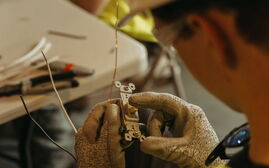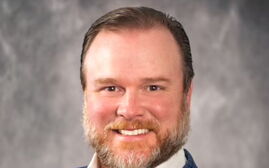Goodwill ratchets up commitment to sustainability and healthy bottom line
 photo/tim greenway
Randy Finamore helped Goodwill stores return to profitability and oversaw the creation of its new distribution center in Gorham
photo/tim greenway
Randy Finamore helped Goodwill stores return to profitability and oversaw the creation of its new distribution center in Gorham
Few local businesses are as inherently green as Goodwill Industries of Northern New England, the Portland-based social services agency that resells items that otherwise would be thrown away. But 10 years ago, it looked like Goodwill's retail monuments of reduce-reuse-recycle might not survive. Few of Goodwill's two-dozen northern New England stores were profitable. They lacked consistent branding, customer service quality or merchandise.
Getting the retail stores in line was a priority, since the stores consistently fund Goodwill more than any other single source of revenue like grants or service fees. (Last year, $29 million of the $63 million budget came from retail revenue.) The retail stores anchor funding for Goodwill's network of more than 60 work force, residential and rehabilitation programs serving more than 100,000 people in southern and central Maine.
So in 2003, Goodwill hired Randy Finamore, L.L.Bean's former operations manager for corporate liquidations, who as a longtime Goodwill board member, had watched the stores' slow decline. Finamore set about counteracting what he refers to as the organization's "general malaise" by first making the store interiors look alike. Signs were printed rather than hand-written and merchandise was displayed in the same way, as Finamore says, "to align a vision that would look to the customer that she was in the same store." Finamore closed remote, underperforming stores and opened locations in shopping centers with more foot-traffic; and codified customer service guidelines to address complaints about some stores' shabby service. He also made sure each of the stores offered the same type of goods, at the same price, including brand-new items like hats, gloves and underwear. By 2006, Finamore's strategy had worked. The stores were profitable again.
Goodwill's retail renaissance is part of a company-wide effort to integrate sustainability into all aspects of strategic planning. The greening of the nonprofit that calls itself "the original recycler" involves ambitious recycling efforts, a new CEO with a history of sustainable leadership and Finamore's latest passion — a bustling new outlet store.
A place for everything
The 106,000-square-foot Gorham Distribution Center opened in February and is key to the company's goal of eliminating its waste completely. From the outside, Goodwill's streamlined central warehouse looks as faceless as a big-box store, just a plain white cube atop a neatly mowed hill deep in a Gorham industrial park. But, inside, the warehouse hums. About 100 employees scuttle between rows of towering steel shelves to the beeping and buzzing of forklifts and the gnashing of a 15-foot bailer crunching metal castoffs like typewriters, bed frames and chairs into tangled cubes for salvage buyers.
In one corner of the warehouse, two women at vertical slicers that resemble sewing machines cut sheets into rags while two other women on work leave from the local prison sift through boxes of old computer parts, stuffed animals and household odds and ends, tossing broken pieces into a large garbage bin.
Last year, of the more than 35.7 million pounds of goods donated to Goodwill's shops in Maine, New Hampshire and Vermont, 38% was sold back to customers, 41% was sold to recyclers, and 21% was thrown away. It's the part that's thrown away that bugs Goodwill employees like Finamore. He sees that waste as not only bad for the environment but also bad for the bottom line.
"What you don't want to do is throw it all out," says Finamore. "What you want to do is increase the value of that donation by diverting those items from the waste stream as much as you can."
Goods are diverted from the dump in several ways at the distribution center. Goodwill sells to salvage buyers in metal, plastics, glass and even stuffed animals for about 25 cents a pound. And thanks to increased recycling efforts over the past year, the nonprofit system-wide has cut in half its trash cost as a percentage of retail revenue from 2.4% to 1.2%. The distribution center also stores collectibles and books to be sold for a premium on websites like Amazon and eBay.
But the real revenue from the Gorham center comes from the Buy-the-Pound outlet store, which occupies one corner of the warehouse. About 80% of items donated to the stores sell in the first two weeks. After five weeks, whatever hasn't moved ends up at the Buy-the-Pound outlet.
On a recent weekday, about 30 people, mostly young mothers, rifled through bins as large as queen-sized beds. Most of the customers here resell items on eBay, Finamore says, and it's common for customers to drive up from Connecticut, New Hampshire and Massachusetts and spend all day filling several bags with stuff that didn't sell at the retail shops. "It's a more rough-and-tumble atmosphere," he says.
Purchases are weighed on large scales built into the floor and priced by weight. The heavier the load, the cheaper the per-pound price. The Buy-the-Pound facility currently sources from five Maine and New Hampshire Goodwill stores and will likely add three more locations by the end of July.
So far, Buy-the-Pound has achieved the sweet spot of the integrated economic, social and environmental sustainability that Goodwill seeks. It's helping the planet — the five participating stores have reduced their waste by an average of 70%; it's helping the people — self-employed moms are turning trash into cash; and it's helping the pocketbook. Since opening in February, Buy-the-Pound has grossed $50,000 per month. During its first year in operation, Finamore expects the Buy-the-Pound outlet will sell $500,000 worth of goods that otherwise would have made pennies on the salvage market or simply been thrown away.
Sustainable roots
Goodwill's turnaround is due in part to point-of-sale metrics standard in mainstream retail. Under Finamore, the company began gathering hourly, daily, weekly and seasonal data on total sales and donations by square footage and type of product. "Now we have a sustainable model that we can [use to] predict the business," says Finamore. "We can predict the sales, we know how much we're getting in donations, and we know how much labor it takes because we've tracked that year over year."
The data has proven reliable. For the past five years, the difference between Finamore's retail budget and actual sales figures has been less than 1%.
Goodwill's emphasis on reduce, reuse and recycle might be most apparent at the Gorham outlet, but the philosophy starts at its Portland headquarters. In September, Goodwill hired Anna Eleanor Roosevelt, granddaughter of Franklin and Eleanor, as president and CEO, based in part on her work greening Boeing as its vice president of corporate citizenship. Roosevelt had become committed to sustainability after a World Business Council for Sustainable Development report showed that the world's population will require the resources of two Earths by 2050 if the current rate of consumption continues unabated.
"That was what made me sit back and say, 'We don't have time to just sit down and talk about this over coffee. We have to really do something,'" Roosevelt recalls.
Roosevelt has called upon Goodwill's board to add a sustainable approach to company management to the strategic plan, which means considering the impact of every decision on the environment, the community and the bottom line.
According to Vice President of Public Affairs Jane Driscoll, integrated sustainability within the company means encouraging its 1,700 employees to find symbiotic internal solutions to problems. For example, job coaches in Goodwill's work force programs would be encouraged to place clients in one of Goodwill's other commercial ventures.
"When you have a lot of different locations and lots of people who have their heads down doing their jobs, they're not always connecting the dots," says Driscoll. "It's about educating people about what's going on in our own company."
The back of Roosevelt's business card, beside a multi-colored Venn diagram with circles labeled "social," "environmental" and "economic" fusing in a "sustainable" center, reads: "Sustainability is the deliberate integration of economic, social and environmental considerations as the driver of our business model to ensure long-term mission fulfillment." Roosevelt considers sustainability the continuation of the legacy she inherited from her famous grandparents.
"I think what I learned from them through my parents is that we have to work at creating the world we want to live in," Roosevelt says. "We have to work at it hard and we have to work at it together, and that the focus needs to be on creating a world for the larger community as opposed to getting what I can get."














Comments